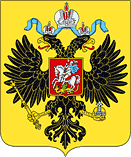
Third Rome
Encyclopedia
The term Third Rome describes the idea that some Europe
an city, state, or country is the successor to the legacy of the Roman Empire
(the "first Rome
") and its successor state, the Byzantine Empire
(the "second Rome").
The seeds of this concept were laid by Constantine the Great, when he moved the capital of the empire from Rome to Constantinople
, which soon came to be referred to as "New Rome
".
 Within decades after the fall of Constantinople
Within decades after the fall of Constantinople
to Mehmed II
of the Ottoman Empire
on 29 May 1453, some were nominating Moscow
as the "Third Rome", or the "New Rome". Stirrings of this sentiment began during the reign of Ivan III of Russia
who had married Sophia Paleologue
. Sophia was a niece of Constantine XI
, the last Byzantine emperor, and Ivan could claim to be the heir of the fallen Byzantine Empire
.
The story of "Third Rome" ("the second Constantinople") started in Tver, during the reign of Boris of Tver
, when the monk Foma (Thomas) of Tver had written The Eulogy of the Pious Grand Prince Boris Alexandrovich in 1453. The idea crystallized with a panegyric
letter composed by the Russia
n monk Philoteus (Filofey) of Pskov
in 1510 to their son Grand Duke Vasili III
, which proclaimed, "Two Romes have fallen. The third stands. And there will be no fourth. No one shall replace your Christian Tsar
dom!". Contrary to the common misconception, Filofey
explicitly identifies Third Rome with Muscovy (the country) rather than with Moscow
(the city). In addition, Moscow is placed on seven hills, as is Rome and Constantinople.
, Italian nationalist and patriot promoted the notion of the "Third Rome". He said, "After the Rome of the emperors, after the Rome of the Popes, there will come the Rome of the people", addressing Italian unification
and the establishment of Rome as the capital.
In his speeches, Italian dictator Benito Mussolini
referred to his Fascist Italy
as a "third Rome." Terza Roma (Third Rome; the Fascist Rome after the Imperial and the Papal ones) was also a name for Mussolini's plan to expand Rome towards Ostia and the sea. The EUR
neighbourhood was the first step in that direction.
Europe
Europe is, by convention, one of the world's seven continents. Comprising the westernmost peninsula of Eurasia, Europe is generally 'divided' from Asia to its east by the watershed divides of the Ural and Caucasus Mountains, the Ural River, the Caspian and Black Seas, and the waterways connecting...
an city, state, or country is the successor to the legacy of the Roman Empire
Roman Empire
The Roman Empire was the post-Republican period of the ancient Roman civilization, characterised by an autocratic form of government and large territorial holdings in Europe and around the Mediterranean....
(the "first Rome
Rome
Rome is the capital of Italy and the country's largest and most populated city and comune, with over 2.7 million residents in . The city is located in the central-western portion of the Italian Peninsula, on the Tiber River within the Lazio region of Italy.Rome's history spans two and a half...
") and its successor state, the Byzantine Empire
Byzantine Empire
The Byzantine Empire was the Eastern Roman Empire during the periods of Late Antiquity and the Middle Ages, centred on the capital of Constantinople. Known simply as the Roman Empire or Romania to its inhabitants and neighbours, the Empire was the direct continuation of the Ancient Roman State...
(the "second Rome").
The seeds of this concept were laid by Constantine the Great, when he moved the capital of the empire from Rome to Constantinople
Constantinople
Constantinople was the capital of the Roman, Eastern Roman, Byzantine, Latin, and Ottoman Empires. Throughout most of the Middle Ages, Constantinople was Europe's largest and wealthiest city.-Names:...
, which soon came to be referred to as "New Rome
New Rome
The term "New Rome" has been used in the following contexts:* "Nova Roma" is traditionally reported to be the Latin name given by emperor Constantine the Great to the new imperial capital he founded in 324 at the city on the European coast of the Bosporus strait, known as Byzantium until then and...
".
Russian claims

Fall of Constantinople
The Fall of Constantinople was the capture of the capital of the Byzantine Empire, which occurred after a siege by the Ottoman Empire, under the command of Ottoman Sultan Mehmed II, against the defending army commanded by Byzantine Emperor Constantine XI...
to Mehmed II
Mehmed II
Mehmed II , was Sultan of the Ottoman Empire for a short time from 1444 to September 1446, and later from...
of the Ottoman Empire
Ottoman Empire
The Ottoman EmpireIt was usually referred to as the "Ottoman Empire", the "Turkish Empire", the "Ottoman Caliphate" or more commonly "Turkey" by its contemporaries...
on 29 May 1453, some were nominating Moscow
Moscow
Moscow is the capital, the most populous city, and the most populous federal subject of Russia. The city is a major political, economic, cultural, scientific, religious, financial, educational, and transportation centre of Russia and the continent...
as the "Third Rome", or the "New Rome". Stirrings of this sentiment began during the reign of Ivan III of Russia
Ivan III of Russia
Ivan III Vasilyevich , also known as Ivan the Great, was a Grand Prince of Moscow and "Grand Prince of all Rus"...
who had married Sophia Paleologue
Sophia Paleologue
Zoe Palaiologina , later changed her name to Sophia Palaiologina , Grand Duchess of Moscow, was a niece of the last Byzantine emperor Constantine XI and second wife of Ivan III of Russia. She was also the grandmother of Ivan the Terrible.- Biography :...
. Sophia was a niece of Constantine XI
Constantine XI
Constantine XI Palaiologos, latinized as Palaeologus , Kōnstantinos XI Dragasēs Palaiologos; February 8, 1404 – May 29, 1453) was the last reigning Byzantine Emperor from 1449 to his death as member of the Palaiologos dynasty...
, the last Byzantine emperor, and Ivan could claim to be the heir of the fallen Byzantine Empire
Byzantine Empire
The Byzantine Empire was the Eastern Roman Empire during the periods of Late Antiquity and the Middle Ages, centred on the capital of Constantinople. Known simply as the Roman Empire or Romania to its inhabitants and neighbours, the Empire was the direct continuation of the Ancient Roman State...
.
The story of "Third Rome" ("the second Constantinople") started in Tver, during the reign of Boris of Tver
Boris of Tver
Boris of Tver or Boris the Great was a prince of Tver.Boris, the son of Alexander II of Tver, was Grand Prince of Tver from April 22 1426 to his death...
, when the monk Foma (Thomas) of Tver had written The Eulogy of the Pious Grand Prince Boris Alexandrovich in 1453. The idea crystallized with a panegyric
Panegyric
A panegyric is a formal public speech, or written verse, delivered in high praise of a person or thing, a generally highly studied and discriminating eulogy, not expected to be critical. It is derived from the Greek πανηγυρικός meaning "a speech fit for a general assembly"...
letter composed by the Russia
Russia
Russia or , officially known as both Russia and the Russian Federation , is a country in northern Eurasia. It is a federal semi-presidential republic, comprising 83 federal subjects...
n monk Philoteus (Filofey) of Pskov
Philotheus of Pskov
Philotheus was a hegumen of the Yelizarov Monastery in Pskov in the 16th century. He is credited with authorship of the Legend of the White Cowl and the Third Rome prophecy....
in 1510 to their son Grand Duke Vasili III
Vasili III of Russia
Vasili III Ivanovich was the Grand Prince of Moscow from 1505 to 1533. He was the son of Ivan III Vasiliyevich and Sophia Paleologue and was christened with the name Gavriil...
, which proclaimed, "Two Romes have fallen. The third stands. And there will be no fourth. No one shall replace your Christian Tsar
Tsar
Tsar is a title used to designate certain European Slavic monarchs or supreme rulers. As a system of government in the Tsardom of Russia and Russian Empire, it is known as Tsarist autocracy, or Tsarism...
dom!". Contrary to the common misconception, Filofey
Philotheus of Pskov
Philotheus was a hegumen of the Yelizarov Monastery in Pskov in the 16th century. He is credited with authorship of the Legend of the White Cowl and the Third Rome prophecy....
explicitly identifies Third Rome with Muscovy (the country) rather than with Moscow
Moscow
Moscow is the capital, the most populous city, and the most populous federal subject of Russia. The city is a major political, economic, cultural, scientific, religious, financial, educational, and transportation centre of Russia and the continent...
(the city). In addition, Moscow is placed on seven hills, as is Rome and Constantinople.
Italian claims
Giuseppe MazziniGiuseppe Mazzini
Giuseppe Mazzini , nicknamed Soul of Italy, was an Italian politician, journalist and activist for the unification of Italy. His efforts helped bring about the independent and unified Italy in place of the several separate states, many dominated by foreign powers, that existed until the 19th century...
, Italian nationalist and patriot promoted the notion of the "Third Rome". He said, "After the Rome of the emperors, after the Rome of the Popes, there will come the Rome of the people", addressing Italian unification
Italian unification
Italian unification was the political and social movement that agglomerated different states of the Italian peninsula into the single state of Italy in the 19th century...
and the establishment of Rome as the capital.
In his speeches, Italian dictator Benito Mussolini
Benito Mussolini
Benito Amilcare Andrea Mussolini was an Italian politician who led the National Fascist Party and is credited with being one of the key figures in the creation of Fascism....
referred to his Fascist Italy
Italian Empire
The Italian Empire was created after the Kingdom of Italy joined other European powers in establishing colonies overseas during the "scramble for Africa". Modern Italy as a unified state only existed from 1861. By this time France, Spain, Portugal, Britain, and the Netherlands, had already carved...
as a "third Rome." Terza Roma (Third Rome; the Fascist Rome after the Imperial and the Papal ones) was also a name for Mussolini's plan to expand Rome towards Ostia and the sea. The EUR
Esposizione Universale Roma
EUR is a residential and business district in Rome, Italy, located south of the city center. The area was originally chosen in 1930s as the site for the 1942 world's fair which Benito Mussolini planned to open to celebrate twenty years of Fascism. EUR was also designed to direct the expansion of...
neighbourhood was the first step in that direction.
See also
- Legacy of the Roman EmpireLegacy of the Roman EmpireThe legacy of the Roman Empire refers to the set of cultural values, religious beliefs, as well as technological and other achievements of Ancient Rome which were passed on after the demise of the empire itself and continued to shape other civilizations, a process which continues to this day.-...
- Legacy of Byzantium
- New RomeNew RomeThe term "New Rome" has been used in the following contexts:* "Nova Roma" is traditionally reported to be the Latin name given by emperor Constantine the Great to the new imperial capital he founded in 324 at the city on the European coast of the Bosporus strait, known as Byzantium until then and...
- Byzantium after ByzantiumByzantium after ByzantiumByzantium after Byzantium is a 1935 book by the Romanian historian Nicolae Iorga, which gave its name to a national cultural movement. It refers to the Byzantine imperial influence on the political, social, cultural, and intellectual development of the principalities of Wallachia and Moldavia...
(novel)

